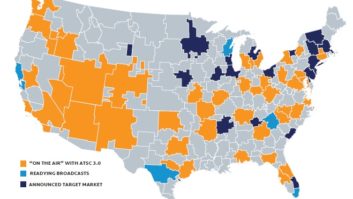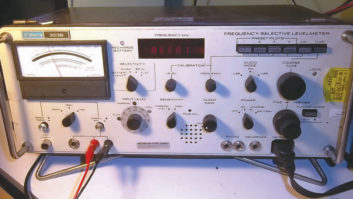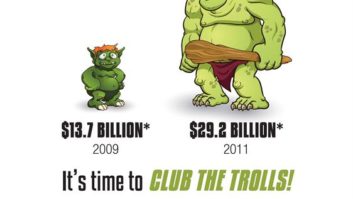
credit: iStockphoto/Noedelhap At the end of October the FCC released the eagerly awaited NPRM for AM improvement, previewed at the fall Radio Show in Orlando. The commission mostly grabbed the low-hanging fruit, proposing to get rid of a number of old counter-productive and restrictive rules that have often frustrated real AM improvement. A proposal to open an FM translator window for AMs-only was the big prize.
Commissioner Ajit Pai certainly needs to be credited as the main force pushing through the new FCC proposals in this NPRM. Like a good politician, Pai has been campaigning actively for AM, visiting and engaging numerous AM stations to feel their pain and discuss how to best fix AM’s thorny problems.
FM Translator Gold Rush
Opening an FM translator filing window for existing AM licensees presents an overdue opportunity for stations to extend or perhaps move their AM programming to an FM channel. Daytimers and stations with poor nighttime coverage have been lobbying for this for decades. Unfortunately, pending translator grants and new LPFM applicants are poised to grab many of the available channels still left due to already scheduled windows. Practically all AM stations in market sizes larger than 150 will be shut out of even applying for a FM translator. Only smaller-market AM stations will likely benefit directly from this proposal.
Many of the details on how such an AM-only translator window would work have not been decided, especially for markets where the demand will exceed the available supply of channels. There’s an opportunity here for the commission to enact bold new initiatives. How about letting stations applying for an FM translator obtain preference if they opt to relinquish their AM channel as a new mechanism for AM interference reduction?
If a new translator covers most of the target audience, AM owners will likely prefer to give up their AM allocation in exchange for a permanent FM license rather than a vulnerable translator. A new Class A1 category could be created to serve this need, and the old AM allocation would then be permanently retired and closed to any new applicants.
AMs that can buy an existing FM translator and then retire their AM should be afforded the same opportunity to convert to a permanent license. Such a rule would instantly restore significant new value to AMs everywhere, something AM owners have lost over many years of negative unintended consequences.
Sadly, nothing in the FCC AM NPRM addresses combating or reducing noise interference, the most destructive universal agent spoiling AM reception. As I pointed out in my previous column (“Last Stand for the AM Band,” RWEE June 12), enforcing existing rules or enacting new laws that could mitigate AM noise generation would appear to be a challenge simply out of reach for an understaffed and underfunded FCC.
All-Digital Gains Ground
Pai and the other commissioners have publicly said little about the benefits of all-digital AM HD as perhaps our long-term solution to the AM problem. They mostly encourage those stations interested in adding the AM HD hybrid mode to do so. Nor have they addressed the possibility of a future analog sunset date for AM.
More all-digital testing is needed and that initiative has been quietly proceeding. Limited data from two more tests in North Carolina were recently announced, following last year’s WBCN impressive daytime tests in Charlotte unveiled at April’s NAB Show.
Greater Media’s WBT, Charlotte and Beasley’s WNCT, Greenville have tested all-digital in recent months, both reportedly producing similar results as WBCN for robustness and dramatically improved quality. Greater Media Vice President of Radio Engineering Milford “Smitty” Smith says WBT’s all-digital AM-HD signal was “remarkably robust” in the Charlotte metro: “For the most part it just hung in there and didn’t fail.” Regarding nighttime performance, Smitty says, “The WBT digital skywave propagation was at least on par with analog propagation and was far superior in terms of quality.”
My instincts tell me all-digital will continue to do quite well in future testing and will also yield room for further improvements as more is learned and the coding is tweaked. You can be sure that effort is moving forward.
Hybrid Shortcomings
Quite a few of my engineering brethren who’ve had a longstanding love affair with AM radio have been hyper-critical of AM HD. They say it can never work and it’s especially harmful to existing adjacent channel neighbors. I would have to agree with those who say the hybrid mode has been a failure. Even the iBiquity inventors undoubtedly realized at the beginning it was going to be tough to make this version of their technology succeed.
The AM band was already clogged with too many allocations without adjacent channel guard bands. Interference levels were already too high to hang digital sidebands that spill into their neighbors to expect good results.
If you remember how HD Radio was born, the NAB and major groups all insisted that upgrading and migrating the radio services to digital had to include AM as well as FM stations. The hybrid mode of HD Radio would simply be transitional.
For AM, that meant lots of new interference and somewhat marginal performance and coverage because of the low injection levels required to protect the analog host. We’ve already increased FM digital power limits to give FM HD hybrid performance significant improvement. Such is not possible for AM. So AM HD in the hybrid mode really never had a chance to succeed.
Deep Doo-Doo
AM HD naysayers rarely acknowledge that the AM band is in fact in very deep trouble, even without hybrid HD. There simply aren’t enough AM HD stations still operating to cause that much interference. It’s all the manmade noise and existing analog stations interfering with each other that are the obvious culprits.
With every passing year, fewer and fewer folks are using AM, now only 17 percent of all radio listeners, according to one number I’ve seen. For the under-30 demo, the share is about 4 percent, according to Edison Research. Extrapolate the curve out another five and then another 10 years and it’s clear AM radio in its present form needs a major makeover to give it a chance to survive and compete in the all-digital electronic world.
A lot of AM analog fans still maintain it’s all about content and that the medium doesn’t matter. If only station owners would put their best content back on AM, all would be well with the senior band again.
That’s actually been tried in a few markets with dismal results.
Apparently those folks missed the great migration of successful music stations from AM to FM in the ’70s and ’80s. When decent FM receivers became mainstream, everybody discovered that music sounded much better on FM. And in recent years, we’re all painfully aware that even AM talk sounds bad riding on a sea of noise and interference.
Which Way to Look?
The difference between the old-school view of what’s good for the AM band and my view is all about which direction you are looking. Those who look backwards dwell on the digital hybrid mode being a disaster. A few even suggest analog DSB would be a better way to extend AM’s analog longevity. If only the FCC would just force all receiver manufacturers to build AM sections with synchronous detectors.
I prefer to look forward and place my bet on a digital future. But like it or not, there’s only one de facto digital standard with significant and growing receiver penetration we have to work with. Digital Radio Mondiale has a fan base of engineers, but it simply hasn’t gained traction anywhere with receiver manufacturers or consumers. Even Canada is reportedly bypassing DRM in favor of all digital AM HD.
Radio is the last major electronic medium not to have fully converted to the advantages of digital delivery. FM is making reasonable and steady progress with its digital conversion. Does the anti-HD crowd really think the AM band has a future staying all-analog? As the wireless Internet takes over increasing chunks of dashboard real estate, do they really think car radios will include the AM band forever?
The car companies might be saying they have no plans to ditch AM for now, but how low will AM’s share of audience need to drop before they change their minds? 10 percent? 5 percent? If the industry doesn’t make significant moves soon to stem that waning tide, it’s not going to be very long before we see AM analog receivers begin to disappear from the car.
The AM band has been steadily losing stations in recent years. Increasing numbers of owners, even large corporations are selling the real estate and either turning in their licenses or giving them away for tax deductions. As more AMs migrate to FM channels and give up their AM allocations, the overdue AM over-population cleansing will accelerate.
For the complete text of the FCC NPRM:
http://www.fcc.gov/document/commission-adopts-nprm-revitalize-am-broadcast-radio-service
AM HD detractors say digital skywave reception will never work. I don’t think iBiquity has begun to fully evaluate the potential improvements that fine-tuning the AM HD coding scheme might deliver in the real world at night when all-digital is implemented. With all-digital modulation that incorporates forward error correction and buffering with time and diversity delay, much of the lost reception due to ionospheric fading should be able to be recovered.
Time To Choose
A mandated sunset of Ancient Modulation forces all existing AM owners to decide which path to take. Do they want to keep their AM stations and be part of an all-digital future? Do they prefer to tough it out with analog-only and hope until the inevitable end? Or would they choose to give up or sell their interests to others who see the value of all-digital AM and want to make it work?
For those who are willing to pursue the opportunity of improving a station that achieves wide-area coverage, high-fidelity audio and new display features with the potential of dramatically reduced interference, the choice of all-digital should be compelling.
For those who’ve been losing money keeping marginal AMs alive with few listeners and are unwilling to take more risks, the decision shouldn’t be that hard. Get a replacement FM translator or sell out to somebody else who is committed to AM long-term. AMs that want to expand coverage and add all-digital HD should consider buying and retiring stations that limit their existing coverage.
Ten years should be more than enough time for stations to make these decisions. By then, a very large majority of vehicles on the road will be equipped with HD Radios that can hear AM all-digital HD. As HD becomes the mainstream radio preference, we’ll see more AM and FM HD-equipped tabletop and portable sets available in the marketplace.
As fewer AM stations populate the dial, it makes perfect sense for the FCC to redefine channel allocations and protections so that most of the adjacent channel interference issues can be eliminated. If 10 years is not quite enough, the sunset deadline for analog can be extended as it was for HDTV.
The clock is ticking and the race to save the AM band is finally getting started. It’s shaping up to be quite the horse race. Like it or not, Ancient Modulation is fading into the noise. I’m betting on the all-digital mount who is ready to run faster and farther. We can only hope there will be a finish line and a pay off.
Guy Wire is the pseudonym of a veteran broadcast engineer. Read his archive under the Columns tab at radioworld.com.
Comment on this or any story. Write to [email protected].









